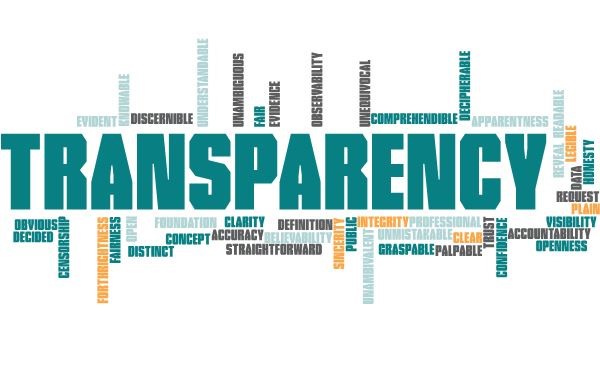
Transparency Word Cloud (Dunworth, 2021).
Transparency, there is more than one definition for this important word. The definition that I am going to use for this article is the second definition from the Merriam-Webster Dictionary (n.d.) “the quality that makes something obvious or easy to understand.” As I was reading for our third module on social justice, I realized how important transparency is, not only our individual transparency, but the transparency of the companies that we interact with online. I also realized that there was a general lack of transparency in some of our digital education practices.
For this module I selected the value of transparency because, as a society, we have become so reliant on the technologies in our lives that we have become accustomed to clicking the agree button without taking the time to read the fine print. In fact, the fine print is so long that it seems to be designed to encourage people to purposefully skip the fine print. I worry about what a lack of transparency and a lack of interest in transparency does to all stakeholders in education/society. Based on this value, I developed the following question:
- Does a lack of transparency in educational technology and technology in general cause harm?
My question above relates to two different ISTE coaching standards, standard 4.7a “Inspire and encourage educators and students to use technology for civic engagement and to address challenges to improve their communities” and standard 4.7d “empower educators, leaders and students to make informed decisions to protect their personal data and curate the digital profiles they intend to reflect” (n.d.).
Transparency in education and educational technology is an issue that is simultaneously regulated and unregulated in the United States. We have the Federal Educational Rights and Privacy Act (FERPA) which was initially enacted in 1974, and since then it has gone through several different iterations. The basic text of the current law requires: “confidentiality of student information by telling schools what information it may share, and when & who they may share such information with. It also gives parents the right to consent to the disclosure of their child’s personally identifiable information (PII)” (Geronimo, 2014). We also have the Protection of Pupil Rights Amendment (PPRA) which protects use of student information for marketing purposes (U.S. Department of Education, 2014). Privacy laws and the enforcement of them in an educational setting directly relate to ISTE standard 7d. How often do we ask students to sign up for a new educational platform without reading the privacy policies and end-user agreements of each company?
While these laws come from a good place, they only protect students when they are being actively followed and when students and families know their rights. Parks (2017) points out that laws like FERPA only work if students know about the law and are educated about it. While many students know that their privacy is not being protected, they continue to use online services because the benefits outweigh the risks in their opinions. Additionally, all K-12 students now, and most college undergraduate students have grown up in the internet era and are more comfortable with the risks, and those risks have even been normalized (Parks, 2017). Parks (2017) also goes on to state that while learning analytics have potentially useful pedagogical outcomes more research needs to be done on FERPA and ensuring that students have a voice in how their data is used.

A lack of transparency in education systems and technologies can cause harm to students. For instance, a lack of transparency in the college admission process causes harm to those students who do not understand the processes (Hossler & Kalsbeek, 2009). In addition to the lack of transparency in the admissions process for universities, there is also a lack of transparency in high-stakes high school exit exams. Students in different states are not necessarily taught the same things and are not assessed on the same subjects. The absence of a national curriculum makes equity in the high stakes testing and admissions process unachievable (Hossler & Kalsbeek, 2009). This issue directly related to ISTE standard 7a because this lack of transparency does not allow for equitable engagement in our educational systems.
Another area where transparency comes into importance is algorithms. Algorithms are basically programming codes that are designed to do a variety of tasks, such as: grading, searching the web, placing marketing ads on your social media feed, etc (Benjamin, 2019). There needs to be transparency in not only how various algorithms are coded, but also in who does the coding. According to Chapman (2016), the diversity of the design staff is important. When it comes to learning software a more diverse team is more likely to be able to create software that will reach more diverse learners (Chapman, 2016). Having diversity will allow for more learners to engage with a particular learning program allowing for increased equity in education. Diversity is also important when creating algorithms for non-educational tools, when a team is homogenous, lacking in diversity, there is a higher probability that the codes they produce will have an accidental bias. This kind of bias is what Benjamin (2016) calls the New Jim Code, discrimination is built right into the code, whether intentionally or not, and it creates harm.

There are solutions to the lack of transparency problem. One such solution is learning technologies need to be continually re-designed and updated. The team in this process should be diverse to help identify any cultural biases, especially in the structural design features (Lits et al., 2020). Another solution to the transparency problem is Open Educational Practices (OEP). OEP is a combination of educational practices that may include Open Educational Resources (OER), as well as open pedagogical practices. One such OEP is the Open Practice Notebook (OPN); this is a digital space where students and teachers can share their experiences with OEP (Bali, et al., 2020). OPN offers the ability to be transparent in the development and execution of OER lessons, it allows for teachers to be reflective on their practices in a fully transparent way (Bali, et al., 2020). Utilizing OPN allows teachers and students to have equality of voice. The concept of OER and OPN directly relate to the Triple E Framework, allowing for engagement in learning, enhancement of the learning goal, and extension of the learning goal for each lesson (Kolb, 2017).
Transparency isn’t just an important issue in educational technology, it is important in the technology that our students are using outside of school as well. Many of our students are on social media, they join for various reasons but mostly to be social with friends. One aspect of social media that is likely not understood by students, and possibly by many adults too, is how the built-in algorithms are manipulating their “feeds”. The recent news articles called “The Facebook Files” published by The Wall Street Journal and the subsequent “Facebook Papers,” the documents shared by the Facebook whistleblower, Frances Haugen, have demonstrated how a lack of transparency in the development of algorithms has caused actual harm to people. Well, Horwitz, and Deep (2021) reported that 13% of teenage British users and 6% of teenage American users could trace their suicidal thoughts to Instagram. Part of this is due to the algorithms that Instagram, which is owned by Facebook, employs. As teens interact with posts, they are more likely see related posts in their feeds. If a young person searches for fitness or weight loss, their feed will become inundated with those posts, same concept if they are searching for posts about suicide or self-harm (Well, et al., 2021). Without a clear understanding of how the algorithm works, it is easy to be led down the rabbit hole. Transparency would help to combat this.
I am going to leave you with a TedTalk titled The Ethics of Collecting Data by Marie Wallace (2014). This Ted Talk was recorded 7 years before The Facebook Papers and is almost prophetic. Transparency is crucial, not only in education technologies, but in all technologies that people interact with.
References
Bali, M., Cronin, C., & Jhangiani, R. (2020). Framing Open Educational Practices from a social justice perspective. Journal of Interactive Media in Education, 1(10), 1-12. : https://doi.org/10.5334/jime.565
Benjamin, Ruha. (2019). Race after Technology: Abolitionist Tools for the New Jim Code. Polity Press.
Chapman, R (2016). Diversity and inclusion in the learning enterprise: Implications for learning technologies. In N. J. Rushby & D. W. Surry (Eds.), The Wiley Handbook of Learning Technologies (pp. 287-300. Wiley Blackwell. https://doi.org/10.1002/9781118736494
Dunworth, M. (2021). Test Day [Digital Image].
Dunworth, M. (2021). Transparency [Digital Image].
Dunworth, M. (2021). Transparency Word Cloud [Digital Image].
Geronimo, V. (2014). FERPA “Do’s and Don’t” Guide for Teachers. Fordham University. Retrieved May 15, 2015, from https://www.fordham.edu/download/downloads/id/1850/09_-_dos_and_donts_for_teachers.pdf
Hossler, D., & Kalsbeek, D. (2009). Admission testing and institutional admissions processes: The search for transparency and fairness. College and University, 84(4), 2-7, 9-11.
International Society for Technology in Education. (n.d.). ISTE standards for coaches. International Society for Technology in Education. Retrieved October 30, 2021, from https://www.iste.org/standards/for-coaches
Kolb, L. (2017, April 19). Social networking the American revolution in a safe space. Triple E Framework. https://www.tripleeframework.com/triple-e-blog/social-networking-the-american-revolution-in-a-safe-space
Lits, B., Searle, K., Brayboy, B., & Kafai, Y. (2020). Computing for all?: Examining critical biases in computational tools for learning. British Journal of Educational Technology, 52(2), 842-857. https://doi-org.ezproxy.spu.edu/10.1111/bjet.13059
Merriam-Webster. (n.d.) Merrian-Webster.com dictionary. Retrieved October 30, 2021, from https://www.merriam-webster.com
U.S. Department of Education. (2014). Transparency Best Practices for Schools and Districts. Privacy Technical Assistance Center. Retrieved October 24, 2021, from https://studentprivacy.ed.gov/sites/default/files/resource_document/file/LEA%20Transparency%20Best%20Practices%20final.pdf
Parks, C. (2017). Beyond compliance: Students and FERPA in the age of big data. Journal of Intellectual Freedom and Privacy 2(2), 22-33. https://journals.ala.org/index.php/jifp/issue/view/636
Wells, G., Horwitz, J., & Seetharaman, D. (2021, Sep 14). Facebook knows Instagram is toxic for teen girls, company documents show; Its own in-depth research shows a significant teen mental-health issue that Facebook plays down in public. Wall Street Journal (Online). Retrieved from https://ezproxy.spu.edu/login?url=https://www-proquest-com.ezproxy.spu.edu/newspapers/facebook-knows-instagram-is-toxic-teen-girls/docview/2572204393/se-2?accountid=2202
Williams, M. (2014, September). The ethics of collecting data. TED Conferences. https://www.ted.com/talks/marie_wallace_the_ethics_of_collecting_data
